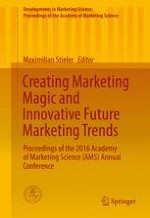2017 | OriginalPaper | Chapter
Need for Touch: A Barrier in Online Shopping—Identifying Compensatory Factors in an Online Context
Authors : Jyoti Pandey, Ashish Sadh, Aditya Billore
Published in: Creating Marketing Magic and Innovative Future Marketing Trends
Publisher: Springer International Publishing
Activate our intelligent search to find suitable subject content or patents.
Select sections of text to find matching patents with Artificial Intelligence. powered by
Select sections of text to find additional relevant content using AI-assisted search. powered by
